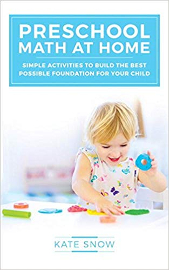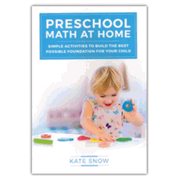In Preschool Math at Home: Simple Activities to Build the Best Possible Foundation for Your Child, Kate Snow shows parents how to use games and hands-on activities to teach foundational math concepts to young children so that learning seems like play rather than work. Snow suggests that most children will be ready for these activities at about age four. Children are not required to do any writing, although you could begin to teach them how to write numerals if they seem ready.
The book has seven chapters with a number of activities per chapter. Most activities gradually increase in difficulty within each chapter. For instance, children first learn the numbers from zero to five, then tackle from six to ten. They learn about numbers with concrete objects first, waiting until the fifth chapter to learn how to identify written numerals. Along the way, children will also learn to count to ten, make one-to-one correspondences while counting, match quantities, compare amounts, understand the concept of zero, and understand addition and subtraction stories using concrete objects and images.
One of the important skills that Snow teaches is subitizing, a skill that helps children learn to recognize quantities without counting. She explains this thoroughly in the introduction, then introduces it in activities within Chapter Three. You will use the “five-frame” and “ten-frame” pages from the appendix for many subitizing activities. (These pages show a line of either five or ten boxes. The ten boxes have a bold line between the two middle boxes.)
This 101-page book provides instructions for parents to follow as they interact with their children. Most families will already have what they need on hand. Snow suggests putting together a math basket where you will keep all of the items so that they are handy. You will need 20 counters (small objects of your choice), one nickel, ten pennies, blank paper, and a writing instrument. You will also need to print the pages from the appendix (on cardstock if possible) for the five- and ten-frames, a simple game board, and number cards. Children use the number cards for many activities and games such as Memory, Go Fish, and Number Scavenger Hunt. You will use other items from time to time—e.g., stuffed animals, paper bags, dice, a blanket—but these need not be kept in the math basket.
Once you have prepared the pages from the appendix, gathered the items you will need, and read the introduction, you can use the activities quickly without advance preparation. Most activities can be done in a very short time, although children might want to do some of them over and over.
Many activities are very simple. For example, activity 1.11 says,
Slowly and deliberately clap two times. Ask your child how many times you clapped. (Two.) Repeat with the other numbers up to five, including zero. Then reverse the process. Ask your child to clap three times. He may do this with or without counting each clap aloud, whichever makes more sense to him. Repeat with the other numbers up to five.
Slightly more challenging are activities such as 4.3, the “Race to Ten Game.” Two players each have a ten-frame page from the appendix. They take turns flipping a coin. If they get heads, they place one counter on their ten-frame. If it’s tails, they get to place two counters. Once they have more than five counters, they announce their total each time as "how many more than five."
Activities build concepts and skills in a logical sequence, but feel free to revisit activities or games that your children particularly enjoy.
Each chapter concludes with a short section, “Is My Child Ready to Move On?” These are simple guidelines to help parents know whether to continue working on concepts in that chapter or move on to the next chapter.
Preschool Math at Home is a fun and playful approach for learning beginning math concepts that both parents and children should enjoy. It’s easy to understand and simple to implement.









